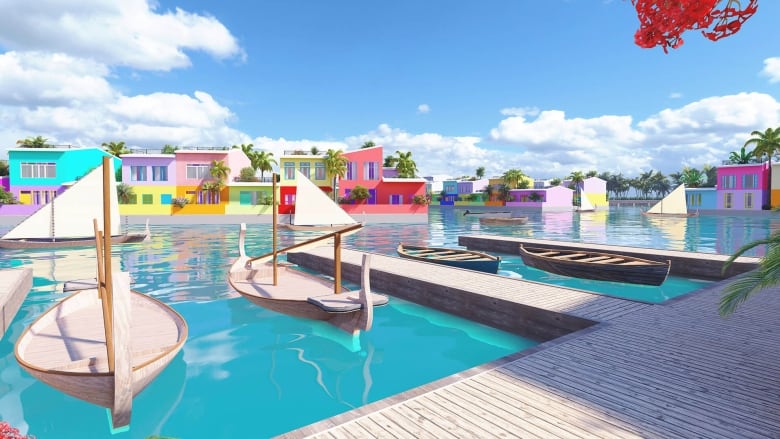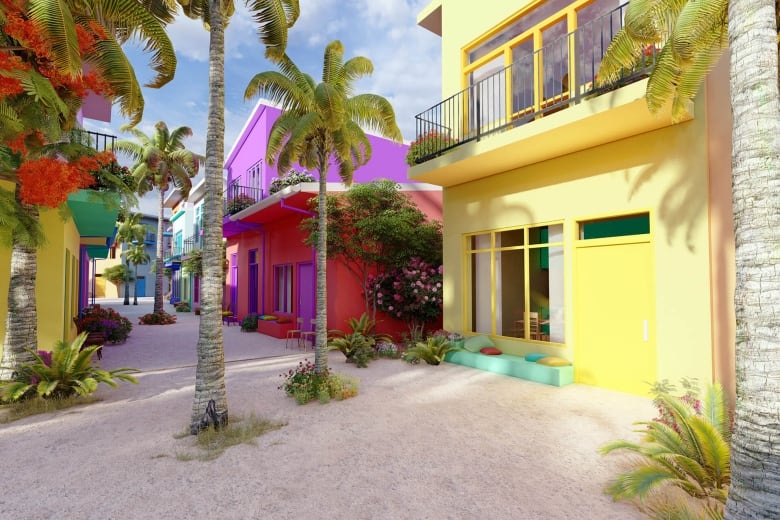
The Maldives are building a floating city to address rising sea levels and population
By Jonathan Ore & Morgan Passi
CBC Radio
2022.June.23
Venture between Maldivian government and a Dutch firm hopes to provide floating homes for 20K people

The Maldives is in the early stages of building an elaborately designed floating city in an effort to ensure future livable spaces, as sea levels continue to rise, and provide new affordable spaces for the densely populated island nation.
The city, currently dubbed “Maldives Floating City,” is a joint project between the government of the Maldives and property developer Dutch Docklands.
“A floating city should look exactly the same like normal cities. So with sandy roads, beautiful, colourful houses. But then if you look under the city, it’s floating,” said Koen Olthuis, architect and founder of Waterstudio, the architectural firm that designed the city.
“That means that the whole city can move up and down with [tides] and with extreme floods and with sea level rise. But it won’t be different than a normal city,” he told As It Happens guest host Tom Harrington.

The city will include a mix of affordable housing as well as higher-end homes, in addition to restaurants, hotels and shops. Prices for the homes will range from $150,000 US ($194,000 Cdn) for a studio apartment to $250,000 ($323,000 Cdn) for family homes.
A total of 5,000 living units are planned, with a capacity of housing 20,000 people once construction is completed some time in 2027. The Maldives and Dutch Docklands are set to unveil its first completed units in the coming weeks, with people starting to move in by 2024.
Abdulla Mausoom, the Maldives’ minister of tourism, said the city “will compliment futuristic, sustainable tourism and living” in a tweet on Wednesday.
Rising sea levels, accelerated by climate change, pose a particularly dire threat to the Maldives, which is made up of over 1,100 islands, many of them barely a metre above sea level.
According to National Geographic, some experts fear it may become the first nation on the planet to disappear entirely beneath sea waters.
The ‘brain coral’ city
Concept art so far depicts brightly coloured homes sitting on calm waters. An overhead view shows a network of buildings and water canals, arranged in patterns resembling brain coral.
The design comes from “the goal of living with nature and leaning to improve and respect natural coral … which leads to new knowledge emphasising the responsibility Maldives takes as centre for coral protection in the world,” reads an explanation on the project’s promotional website.
As Olthuis explains, much of the Maldives are surrounded by coral reefs, some of which should help protect the 200-hectare floating city from the worst storms and other extreme weather the Indian Ocean might offer.

The Maldivian capital Malé itself is one of the most densely populated cities in the world, with a population of over 200,000 people packed on an island about eight square kilometres across.
Olthuis said you might consider the floating city an extension of Malé itself because of its close proximity, allowing residents access to already-existing infrastructure such as schools and health-care.
Possible living solutions for around the world
This isn’t the only time a floating city has been proposed as a direct answer to rising sea levels. The South Korean city of Busan announced in December that it was working on a prototype for Oceanix, a similar city that would expand off the coast of the shipping city of Busan.
The Busan government announced it was a joint project with UN-Habitat, the United Nation’s agency for urban and sustainable development.

Olthuis said the Maldives project has been in the works for nearly 10 years, and that the planning and design work that has so far gone into the Maldives city could be applied to similar projects in other coastal communities around the world threatened by rising sea levels.
“If you look at Miami, New York, Tokyo, Shanghai, they all have the same problems: lack of space, threat of sea level,” he said.
“They have to make the move from fighting against the water, to living with water.”